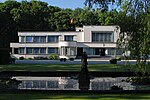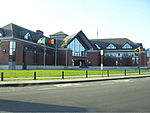European School of Bruxelles-Argenteuil

The European School of Bruxelles-Argenteuil (French: École Européenne de Bruxelles-Argenteuil), also known as the EEBA, is a private, Accredited European School located on the grounds of the Château d'Argenteuil, in Waterloo, 15 km south of Brussels, Belgium. Founded in 2016, the EEBA is a partnership between the Belgian private school "Lycée Molière", and the Scandinavian School of Brussels (SSB). The EEBA, through its partnership with the SSB, offers its students the International Baccalaureate as its secondary leaving qualification, with plans to also offer the European Baccalaureate in the near future. The school caters to nursery, primary and secondary students and is equipped with facilities for boarders aged 15 and up.
Excerpt from the Wikipedia article European School of Bruxelles-Argenteuil (License: CC BY-SA 3.0, Authors, Images).European School of Bruxelles-Argenteuil
Drève du Château,
Geographical coordinates (GPS) Address Nearby Places Show on map
Geographical coordinates (GPS)
| Latitude | Longitude |
|---|---|
| N 50.71746 ° | E 4.4282 ° |
Address
Scandinavian School of Brussels
Drève du Château
1410
Walloon Brabant, Belgium
Open on Google Maps







